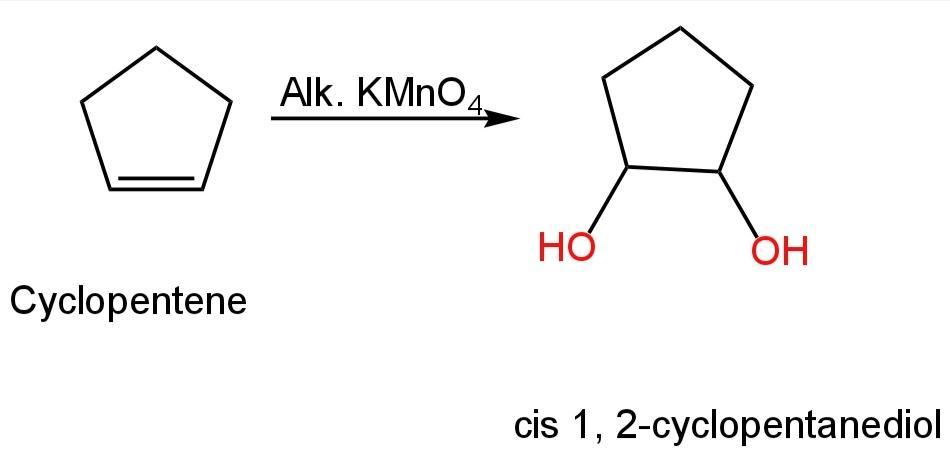
Cyclopentene on treatment with alkaline potassium permanganate gives
A. Cyclopentanol
B. Trans 1, 2-cyclopentanediol
C. Cis 1, 2-cyclopentanediol
D. 1:1 mixture of cis and Trans-1,2-cyclopentanediol
Answer
219.9k+ views
Hint: Cycloalkenes are ring compounds with one or more double bonds in the molecule. Cyclopentene is a type of cycloalkenes. Cyclopentene on treatment with alkaline potassium permanganate undergoes oxidation as alkaline potassium permanganate is a strong oxidising agent.
Complete Step by Step Answer:
Cycloalkenes are cyclic compounds possessing one or more double bonds in the molecule. Cyclopentene is a type of cycloalkenes.
Potassium manganate(VII) solution when added to sodium carbonate solution becomes little alkaline. The purple solution initially becomes dark green and then develops a dark brown precipitate. Alkaline potassium permanganate is a strong oxidising agent which undergoes reduction itself.
Under an alkaline climate, the manganate (VII) ions are initially reduced to green manganate (VI) ions.
Manganate(VII) ions are a powerful oxidising agent and oxidise cyclopentene to cis 1,2-cyclopentanediol.
The alkaline potassium manganate (VII) solution makes the cyclopentene undergo oxidation by breaking down the carbon-carbon double bond and altering it with two bonds in which carbon is attached to the hydroxyl group. This is a cis isomer because two bonds in which carbon is attached to the hydroxyl group
bonds are on the same side.
The reaction happens as follows:-

Image: Conversion of cyclopentene into cis 1, 2-cyclopentanediol.
So, option C is correct.
Note: Alkenes react with potassium manganate(VII) solution. It is a purple colour solution. The colour modification relies on whether the potassium manganate(VII) is utilised in acidic or alkaline conditions.If the potassium manganate(VII) solution is mixed with dilute sulfuric acid, the purple solution becomes colourless.
Complete Step by Step Answer:
Cycloalkenes are cyclic compounds possessing one or more double bonds in the molecule. Cyclopentene is a type of cycloalkenes.
Potassium manganate(VII) solution when added to sodium carbonate solution becomes little alkaline. The purple solution initially becomes dark green and then develops a dark brown precipitate. Alkaline potassium permanganate is a strong oxidising agent which undergoes reduction itself.
Under an alkaline climate, the manganate (VII) ions are initially reduced to green manganate (VI) ions.
Manganate(VII) ions are a powerful oxidising agent and oxidise cyclopentene to cis 1,2-cyclopentanediol.
The alkaline potassium manganate (VII) solution makes the cyclopentene undergo oxidation by breaking down the carbon-carbon double bond and altering it with two bonds in which carbon is attached to the hydroxyl group. This is a cis isomer because two bonds in which carbon is attached to the hydroxyl group
bonds are on the same side.
The reaction happens as follows:-

Image: Conversion of cyclopentene into cis 1, 2-cyclopentanediol.
So, option C is correct.
Note: Alkenes react with potassium manganate(VII) solution. It is a purple colour solution. The colour modification relies on whether the potassium manganate(VII) is utilised in acidic or alkaline conditions.If the potassium manganate(VII) solution is mixed with dilute sulfuric acid, the purple solution becomes colourless.
Recently Updated Pages
Electricity and Magnetism Explained: Key Concepts & Applications

JEE Energetics Important Concepts and Tips for Exam Preparation

JEE Isolation, Preparation and Properties of Non-metals Important Concepts and Tips for Exam Preparation

JEE Main 2021 July 25 Shift 1 Question Paper with Answer Key

JEE Main 2021 July 22 Shift 2 Question Paper with Answer Key

States of Matter Chapter For JEE Main Chemistry

Trending doubts
JEE Main 2026: Application Form Open, Exam Dates, Syllabus, Eligibility & Question Papers

Derivation of Equation of Trajectory Explained for Students

Hybridisation in Chemistry – Concept, Types & Applications

Understanding the Angle of Deviation in a Prism

Understanding Atomic Structure for Beginners

How to Convert a Galvanometer into an Ammeter or Voltmeter

Other Pages
Solutions Class 12 Chemistry Chapter 1 CBSE Notes - 2025-26

NCERT Solutions For Class 12 Chemistry Chapter 1 Solutions - 2025-26

The D and F Block Elements Class 12 Chemistry Chapter 4 CBSE Notes - 2025-26

NCERT Solutions for Class 12 Chemistry Chapter Chapter 7 Alcohol Phenol and Ether

NCERT Solutions ForClass 12 Chemistry Chapter Chapter 8 Aldehydes Ketones And Carboxylic Acids

JEE Advanced Marks vs Ranks 2025: Understanding Category-wise Qualifying Marks and Previous Year Cut-offs




